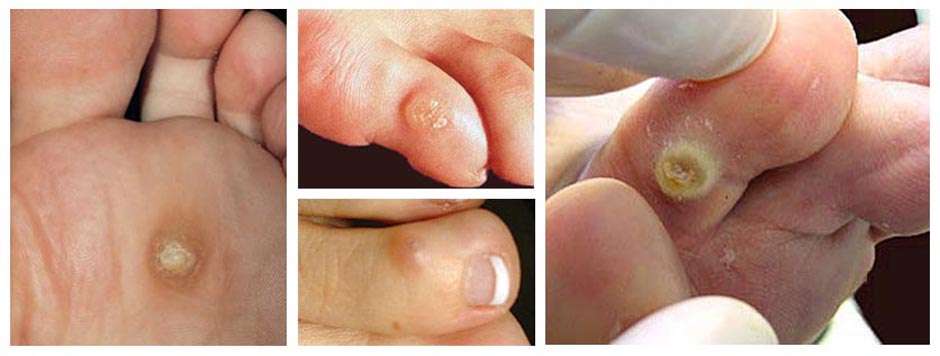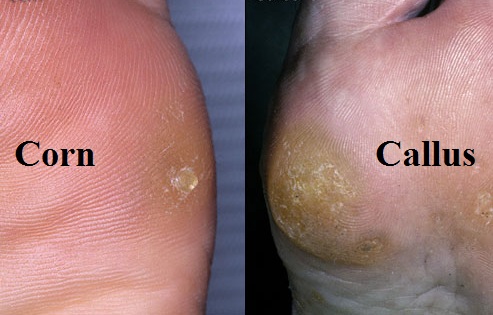Corns are bumps on your body that look like kernels of corn. They are created by pressure and friction which make them very similar to calluses. They may also develop when toes are improperly shaped, do not fit together well and are jammed into shoes that are too small. Corns are extremely painful on the top where they rub against your shoe, but they are also very painful at the point of pressure where the root is growing inside your toe. Continue reading for a more detailed description of corns and when they are severe enough that you need to contact your doctor.
What Does a Corn Look Like?
A corn looks like a cone shaped horn that is growing into your toe. It is a very thick mass of skin found mostly on the outer surface of you your little toe, but it may also develop on the upper surface of other toes or in between them.

The hard corns, which are very thick and firm, develop mostly on the outside of your toes. There may be a yellow ring around it with a center that looks gray. The soft corns are the ones which develop between the toes because the moisture between the toes keeps them soft.The soft corns may also resemble open sores.
Corns vs. Calluses
Corns and calluses may seem similar, but they are not the same thing. A corn is generally smaller in size than a callus.They have a hard, pointy center which is enveloped with red, inflamed skin.Most of the time, a corn will occur on the top and sides of your toes where you do not bear weight. A corn is extremely painful when pressure is placed upon it.
A callus, on the other hand, is not normally painful. Most of the time, they occur on the bottom of your feet around your heels and balls. They are also commonly found on the palms of your hands and tops of your knees. Calluses are larger than corns and vary in size and shape. Unlike the corn, the callus is more of a flat which is thicker than the rest of your skin and does not come to a point.

Do I Need to See a Doctor?
After trying several home remedies without any sign of recovery, or if the corns continue to be painful, then you need to contact your doctor. If you have diabetes, numbness, or poor circulation, you need to seek immediate attention as soon as you have answered the question "what does a corn look like", because you may be at a higher risk for infection. Most of the time, a corn is not a cause for emergency medical attention, however if you notice any of the following symptoms, you need emergency care:
- Redness that continues to spread
- Anything oozing from the wound
- Excruciating pain or swelling
- A fever
- Toes or fingers that are changing color
How to Treat a Corn
1. Remove Hard Skin
You can rub down the hardened skin with a pumice stone or foot file. If it is severe, your podiatrist may use a scalpel to cut away some of the skin.
2. Apply Food Care Products
Ask your medical professional for a product that works best for you. Some products which may be recommended include:
- Rehydration cream
- Plasters which protect the corn
- Softer insoles or inserts
- Foam or silicone wedges between toes
3. Use Salicylic Acid
Some over-the-counter products contain salicylic acid, such as 40% salicylic acid pads. These products soften the skin so that the top layer of dead skin may be removed. When using these products, it’s important that you follow the instructions, most of which suggest repeating using every 48-72 hours for no longer than two weeks or until the corn is gone.
4. Try Topical Products with Urea
Other over-the-counter products contain 45% urea. These products also soften the skin and help remove old, dead skin. It is recommended to use the product two times per day.
5. Soak Your Feet
Soaking your feet will be the first thing you want to do after learning the answer to "what does a corn look like". Soak in warm water to help soften the thick skin. Make sure you dry your feet thoroughly, then use a pumice stone or file to rub away the dead skin. You can do this daily.
6. Wear Shoes That Fit
You can help heal your corns by wearing shoes that fit properly. This means that they do not rub against your feet, your foot doesn’t slide inside, and you have plenty of room for your toes to wiggle.
7. Wear Socks
Always wear socks when you wear shoes. Choose well-fitted socks that are designed for your activities or shoes.
8. Use Protective Coverings
Pads placed on the corn will prevent it from further friction. Lamb’s wool and toe separators are helpful at alleviating friction and pressure as well.
9. Ointments
Reduce the chance of infection with antibiotic ointments.
10. Orthotics
If the corn has caused you certain level of deformity, you may need to wear some padded shoe inserts which would be prescribed by your doctor, so that the corn would not recur.
11. Surgery
In severe cases, it may be imperative to have surgery. The surgery will remove the corn and correct the bone alignment that is causing the excess friction.
